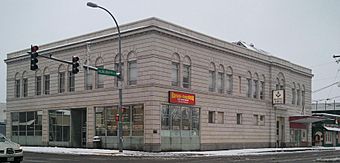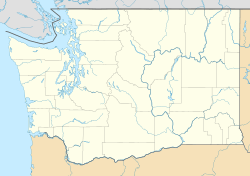Auburn Masonic Temple (Auburn, Washington) facts for kids
Quick facts for kids |
|
|
Masonic Temple-Auburn
|
|

Photographed in 2014
|
|
| Location | 10 Auburn Way S., Auburn, Washington |
|---|---|
| Built | 1923-24 |
| Architectural style | Renaissance Revival |
| NRHP reference No. | 15000454 |
| Added to NRHP | July 21, 2015 |
The Auburn Masonic Temple is a historic building located at 10 Auburn Way South in Auburn, Washington. It was added to the National Register of Historic Places in 2015. This building is special because it's a very fancy and city-like building for a town that was quite small back then. It's also the only meeting hall in Auburn that is still used for its original purpose today.
History of the Auburn Masonic Temple
People in the farming town of Auburn (which was first called Slaughter) started talking about forming a local Masonic group as early as 1886. These people had been part of the Masons in other places they lived. They asked another Masonic group in Renton to help them start a new one.
In May 1889, just before Washington became a state, they got permission to start their new group. A year later, on June 11, 1890, their group, King Solomon Lodge No. 60, officially began. The Masons were the second social group to start in Auburn, right after the Knights of Pythias.
The Masons in Auburn were proud that Lt. William Slaughter, who the town was named after, was a past leader of another Masonic group. They were also proud that Elisha P. Ferry, the first governor of Washington State, was a past Grand Master of the Masons. Many early leaders in Auburn, like C.H. French and Aaron Neely, also joined King Solomon Lodge No. 60.
Like other Masonic groups, Auburn's Masons helped each other, socialized, and got involved in the community. In its early years, the Lodge faced two big problems. In 1897 and again in 1898, fires destroyed all their records and special items. But the group kept going strong.
In 1901, a women's group called the Order of Eastern Star was formed. Other related groups, like the Order of the White Shrine of Jerusalem and the Royal Arch Masons, also started in the early 1920s.
Auburn grew a lot because of the railroad. In 1900, the Northern Pacific railroad changed its main route to go directly through Auburn. This made the town a major transfer point for trains going to Seattle, Tacoma, and other places. The railroad helped local farming and businesses grow.
Between 1900 and 1910, Auburn's population doubled. The town built its first city hall, a better water system, a new library, and a high school. Many community groups, including the Masons, also grew.
In the 1920s, with the town doing well, the Masons decided to build their own temple. For many years, King Solomon Lodge No. 60 had met in rented halls around town. They owned some land, but they wanted their new building to be on Main Street, which was the busy commercial area. Brother Aaron Neely and his wife Sarah donated a new building site on East Main and C Street SE (now Auburn Way S.).
Work on the new building started in September 1923. A special ceremony to lay the cornerstone happened on January 10, 1924. The local newspaper reported on the event, noting that many people attended. The first meeting in the new Masonic Temple was held in June 1924.
After moving into the new building, King Solomon Lodge No. 60 continued to grow and help the community. They formed youth groups like DeMolay, Rainbow Girls, and Job's Daughters in the 1920s. The number of members grew from 192 in 1924 to a high of 451 in 1961.
Over the years, the Lodge held many social events, like the annual Children's Christmas Party. They also rented out their dance hall to other groups. The Lodge helped with community projects, from developing parks to social services. Today, they have a scholarship program for high school students and give reading books to local schools.
King Solomon Lodge No. 60 is still active today. The Masonic Temple is the only building of the six major social groups that once operated in Auburn that is still used for its original purpose. In July 2015, the Auburn Masonic Temple was officially listed on the National Register of Historic Places.
Architecture of the Temple
The Auburn Masonic Temple was designed by the architects Heath, Gove & Bell. They used the Italian Renaissance Revival Style. This style was inspired by the beautiful buildings of wealthy families in Italy from the 1300s and 1400s. The word "Renaissance" means "rebirth." Designers of the original Renaissance style studied old Greek and Roman buildings. They wanted their buildings to show wealth, artistic skill, and pride.
This style became popular again in the early 1900s. In the Pacific Northwest, the Italian Renaissance Revival Style was mostly used in the mid to late 1920s. It was often chosen for public buildings like libraries, social halls, courthouses, or banks. You can also find examples in large homes and apartment buildings.
Buildings in this style are usually rectangular. They have balanced front walls made of brick or stone, with fancy details made of cast stone or terra cotta. Often, the ground floor looks strong and rough, and the corners of the main front have special block designs.
Other features include clear divisions between floors, often marked by decorative bands. Windows on different floors might look different. Some windows are round at the top, with two panes of glass under one arch. The buildings usually have flat roofs that are hidden by decorative tops or short walls. The Auburn Temple is a great example of this style.
The Temple has had a few changes over the years. New windows and doors were put in the upper-story shops around the 1960s. A metal awning was added over the shop on the East side, which is now a comic book store. Drop ceilings were placed over the original ceilings, except in the East side shop. An elevator was also installed to reach the second floor around this time.
Images for kids



